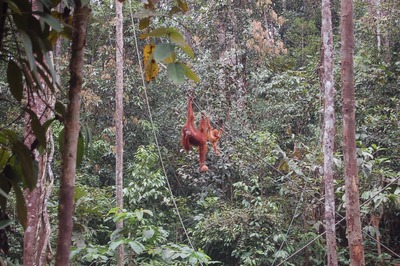Tree planting at this nature reserve alone may not fulfil Miri’s need for urban reprieve, reports Mallika Naguran at Borneo Jazz Festival 2016.
Miri, 12 May 2016. Musicians, journalists, students, politicians and Shell staff came together this morning to plant trees at the start of the two-day Borneo Jazz Festival in Miri, Sarawak.
The act of tree planting at this musical event can be seen as a symbolic gesture. It is also a reminder for all - from the producers of fossil energy to consumers - to conserve the forests and natural areas of Sarawak, which have taken a hit with increasing deforestation due to urban and agricultural development.
The Sarawak Forestry Corporation sponsored 67 tree seedlings that are indigenous to Sarawak, which were planted at the Piasau Boat Club compound. The three species planted were: ranggu/sentang, Azadirachta excelsa; bungkang, Eugenia grandis; and kasai, Pometia pinnata.
Klazz Brothers love tree planting at Borneo Jazz 2016
“It feels good to be part of tree planting here in Malaysia. In Cuba, tree planting takes place all the time, from schools to concerts and festivals, and we love it!” said Roland Grzegorz Abreu Krysztofiak, a musician from Klazz Brothers & Cuba Percussion. "But back home we get our hands dirtier as we really dig in and for many hours!" he added.
Piasau Historical Development and Now
Shell’s interest and involvement in Piasau Nature Reserve (PNR) stemmed from its ownership of what was formerly known as Shell Piasau Camp, a residential area of the expatriate community in Miri, mostly from the oil and gas industry.
Shell first began operations in Sarawak by drilling for oil in Miri 125 years ago, according to Jonathan Jolly, Government Relations Manager, Sarawak Shell Berhad Miri. Apart from greasing the economic growth of Malaysia, Shell sees itself as an important stakeholder of local communities. “We continue to invest in the areas of health, environment, capacity building, arts, culture and more,” said Jonathan at the event.
Shell and the Sarawakian government, at the request of many residents, decided to create a “green legacy” in this area. This initiated the transfer of land rights from Sarawak Shell Berhard to Sarawak Forestry Commission in 2015. Before the handover, efforts were already made to preserve the tree population in the area. As such, Piasau Camp area was gazetted as a nature reserve in 2014. This means that Piasau Camp has been accorded legislative protection against development, encroachment and poaching.
According to the forestry department, PNR has 17 species of fauna protected under the Wildlife Protection Ordinance, 45 bird species (including the hornbill), three mammal species, five amphibian species, 12 reptile species, 10 butterfly species and 107 plant species.
“There are 21 Oriental-pied hornbills, to date,” said Mr. Kamal Abdullah of Sarawak Forestry, who told Gaia Discovery that more can be done to conserve the forest and promote species’ habitats, starting with educational walks and activities.
Piasau - Beyond Conservation
Among those who called for the Piasau Camp to be conserved as a natural reserve rather than a commercial development was YB Datuk Lee Kim Shin, citing the need to preserve both built and natural heritage areas with more conservation activities within the reserve.
Awareness of the PNR among Miri residents is still not as high as desired, apparently. “With more environmental and eco-tourism events and conferences taking place within the reserve itself instead of the city centre, we hope that the Piasau Nature Reserve will become an icon among the urban parks in Miri and in Malaysia,” said YB Datuk Lee Kim Shin, Assistant Minister of Social Development & Assistant Minister of Communication, Sarawak.
While this nature reserve in Miri has been accorded national recognition, and efforts to plant more trees are done on a regular basis, this is still not enough. Musa Musbah, Chairman of the Malaysian Nature Society (MNS) Miri Chapter, is calling for more land to be converted for wildlife to flourish.
“Conserving the forest for iconic birds like the hornbill is one thing, but the other more pressing matter is to enlarge the boundary of the PNR to include the land surrounding the Miri River and in front of the beach,” revealed Musa to Gaia Discovery. This, he says, would increase the present acreage at 88.5 hectares (ha) by another 40 ha, which will boost wildlife survival and growth.
To compare its size to another prominent wildlife area - the Semenggoh Nature Reserve in Kuching at 653 ha - the PNR s rather small.
“I have been pushing for more land conversion for nature every year, and I keep getting nowhere. I am so frustrated,” he added. It is understood that the surrounding land areas referred to may in future be developed for commercial purposes.
If this were to happen, it would make the PNR a very small green lung for Miri, and miles away from achieving the iconic status that Datuk Lee desires.
The tree planting event at Borneo Jazz Festival 2016 was organised by Shell, Sarawak Forestry and Sarawak Tourism Board.



